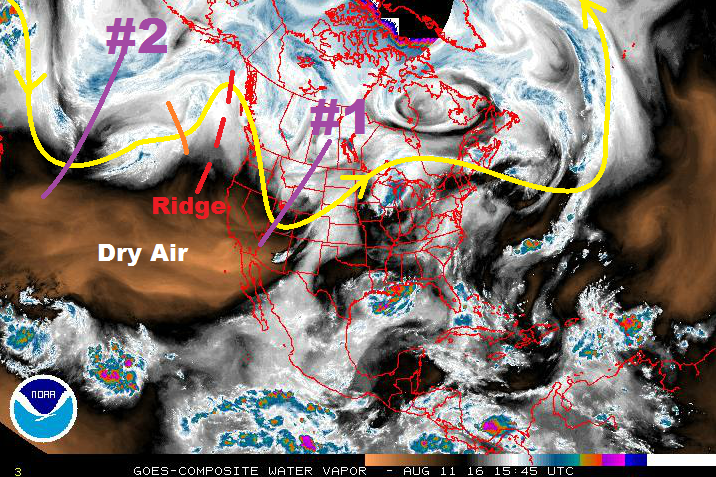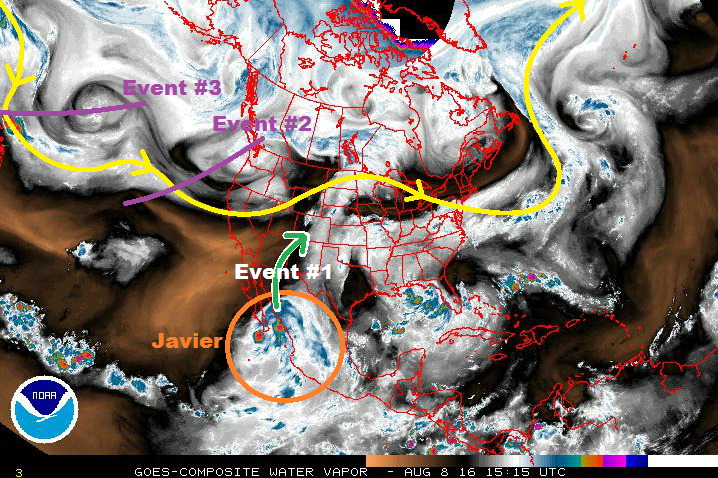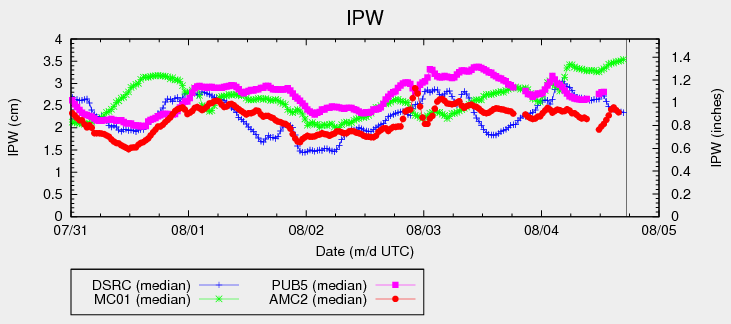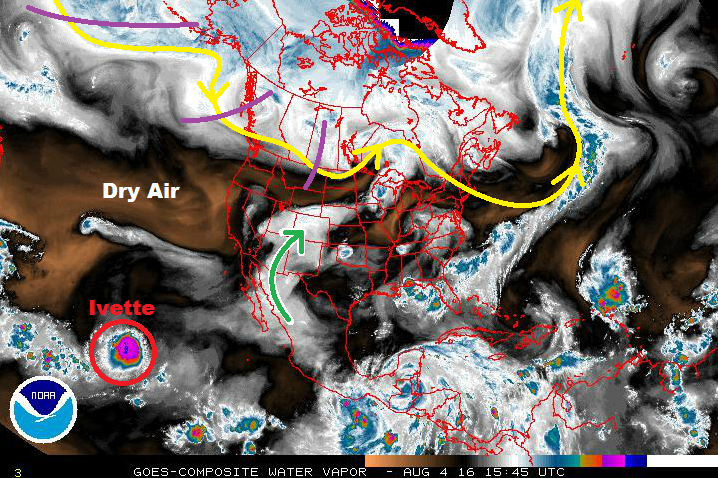Issue Date: 8/11/2016
Issue Time: 1:07 PM
Current water vapor analysis (below) shows the key features with regards to this edition of the FTO. Event #1 is currently underway (Thursday was highlighted as the beginning to this event in Monday’s FTO), and will continue through Saturday as the upper-trough (marked by the purple line, #1) sweeps across the northern US. The trough is in the process of pushing a cool front through the state today, and behind it will be the return of upslope flow. This will provide a slight uptick in low-level moisture for eastern Colorado on Friday, as well as enhance wind shear, leading to the return of organized convection, with a few storms on the strong/severe side. For Saturday, more thunderstorms are in the forecast, although a downtick in coverage and intensity is expected due to lesser instability/shear values, as well as slightly less moisture.
For western Colorado, the drier air that is noted in the water vapor image will continue to push in as the upper-level ridging (red dashes) builds aloft, subduing the majority of convection. A few isolated showers/thunderstorms will pop up over the higher terrain, working on residual moisture and orographic effects. Overall, the area will be mainly dry, with mostly sunny skies dominating a majority of the region.
After Event #1, a drier period will take hold of Colorado as upper-ridging builds aloft and precipitable water values fall due to the influx of drier air. Isolated showers and garden variety thunderstorms will develop over the higher terrain due to daytime heating and orographic effects, resulting in mainly gusty winds and light rainfall. A weak disturbance threatens to break up the dry pattern on Tuesday/Wednesday (orange line), but it remains to be seen where its eventual path will take it. At this time, it looks to pass too far north and east to bring meaningful precipitation to Colorado, but it needs monitoring.
Event #2 will be associated with the upper-level trough marked on the water vapor image above. Currently, the timing for its impacts to reach Colorado will be Friday, August 19th. No flood threat is apparent at this time as there is too much uncertainty regarding its eventual path and the amount of moisture that can return ahead of it. Much will depend on the eventual movement/placement of the upper-level high pressure center, and whether or not monsoonal flow will make a return. Models have been wishy-washy, which reduces our confidence in any particular outcome. Stay tuned to Monday’s FTO for more on this time frame.
Event #1: Friday (08-12-2016) and Saturday (08-13-2016)
Elevated Flood Threat due to Upslope Flow and Potential for Stronger Thunderstorms
Behind the cool front of today will be the return of upslope flow. Due to this, an uptick in wind shear, instability, and moisture is expected, which will lead to more organized convection across eastern Colorado. A few storms will be on the strong/severe side of the scale, producing strong winds, hail, and locally heavy rainfall. For Saturday, a slight downtick in coverage and intensity is expected, but the flood threat will continue, mainly for southeastern Colorado.
Event #2: Friday (08-19-2016) through Monday (08-22-2016)
No Apparent Flood Threat as Details Remain “Cloudy”
Event #2 is associated with the next upper-level trough poised to swing across the western United States. No flood threat is apparent at this time as there is too much uncertainty regarding its eventual path and the amount of moisture that can return ahead of it. Much will depend on smaller-scale features not evident at this time, including the development of any cool fronts/lee side troughs, monsoonal flow returning, and any other small-scale disturbances in the flow. Not helping matters is that models have been wishy-washy of late, which reduces our confidence in any particular outcome. The precipitation map below represents our latest best thinking, but be aware that it will likely be adjusted as we move forward. Stay tuned to Monday’s FTO for more on this time frame.









